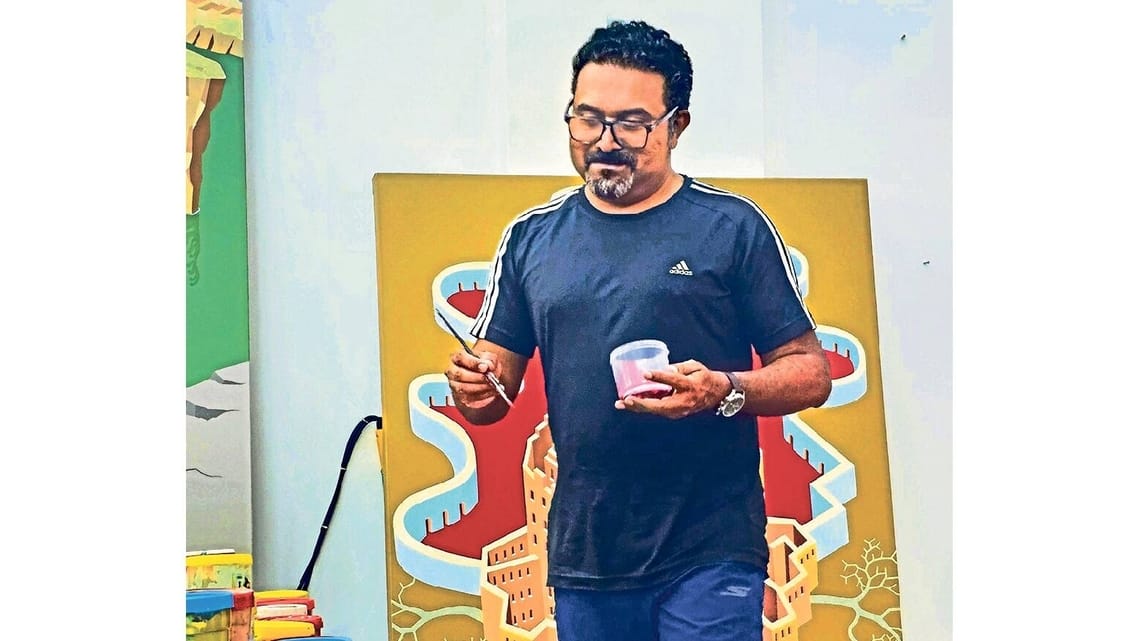Usually artists buy a studio space and then a home, but with Gigi Scaria, 50, it has been the other way around. “I have always had my own home in Delhi, ever since I could afford it,” says the multidisciplinary artist, whose practice spans photography, painting, sculpture, video and installation. But he finally got his own studio space in Greater Noida only one and a half years back. “The answer, perhaps, lies in my practice. I never thought I would want to stick to one medium. There were lots of ideas floating around, so one didn’t feel the need for one particular space to create work. However, now that I have my own space, I know what I was missing out on. I have realised that mental space and studio space are interconnected.”
The studio, which he shares with his artist wife, Prerna Sharma, allows him not just to increase the scale of his paintings, but also gives an opportunity to display some of the new works. Sculptures and paintings that come back from shows can now be categorised and stored properly. “With its high ceiling, it offers a nice open working area, and has a very nice vibe. This also adds to the thought process. Unless you come to a space like this, you wouldn’t understand its importance, as one is used to managing with the bare minimum,” he says.
SIMILAR STORIES
Scaria’s multidisciplinary practice, which has always focused on movements and migrations within the urban cityscape, has emerged organically. When Scaria—who’s from Kothanalloor village in Kerala—moved to Delhi at the age of 22, he would work out of a one-room set-up which doubled as home. The table was the workspace, where he would write, scribble and draw. After enrolling in Jamia Millia Islamia, the workspace shifted to the institution. “I got an Inlaks scholarship in 2002 to work in Italy for six months. There, the practice became more concept-oriented.”
Also read: Into the artist’s studio: For Varunika Saraf, the studio is a place of record
On returning to India, however, he struggled to find work. That period saw him leave the studio practice of painting and drawing and move towards video art. “All one needed was a camera, desktop and editing software. This went on till 2005. Finally I got a solo show, Absence Of An Architect, featuring my paintings, photographs and video works, to be held in 2007 at the Palette Art Gallery, Delhi. To prepare for that, I rented a studio space. It was not ideal, but at that time I couldn’t afford a big open space in an industrial area in Delhi,” Scaria says. The ensuing years saw him working out of a roadside property in Rohini with shutters in front, and other makeshift places in residential areas.
Meanwhile, the scope of his work expanded. Though the thinking and ideating still took place at home, he started to hire a video and a photo editor in Khirkee village—they continue to collaborate even now—as he needed expertise with colour correction and printing on archival paper. Scaria also started making bronze sculptures five-six years ago, for which he needed a foundry. “I connected with one such foundry in Jaipur. I would rent a room in the city for 10-15 days and create models in clay. The people there would then assist me in moulding, waxing and casting. So, the idea of the workspace was fluid—I was navigating through many of those,” he says.
Finally, when he moved to Greater Noida, his wife started working out of a shared space with other artists close to home. When he saw the impact that a dedicated space can have on one’s mental peace, Scaria realised it was time that they bought a studio. “This is my 12th working space,” he laughs. For sculptures, he still heads to Jaipur, but he can now return to his first love, painting, in a big way. “The dimensions and visual dynamism have changed. I am working on a new body of work—large-scale paintings—for an exhibition at Chemould Prescott Road, Mumbai, to be held later in the year. I am simultaneously working on sculptures and videos to be shown at the show. Instead of working on one medium at a time, now I can multi-task on several altogether.”
Also read: Into the artist’s studio: For Baaraan Ijlal, the self is the studio
Some of the objects in his studio are reflective of the journey that he has undertaken. For instance, when he came to Delhi, he didn’t even possess a table. A friend, who was about to leave the city, was selling his existing furniture. Scaria ended up buying a small folding table from him—an object that has stayed with him all these years. “I have some of my older smaller sculptures, which I love and don’t want to dispose of. I never had a habit of collecting natural objects—that has never been part of my journey. Since I never worked out of big spaces, I didn’t want to clutter them. I like neat, organised workspaces, and it’s a habit that continues to stay,” says Scaria.

